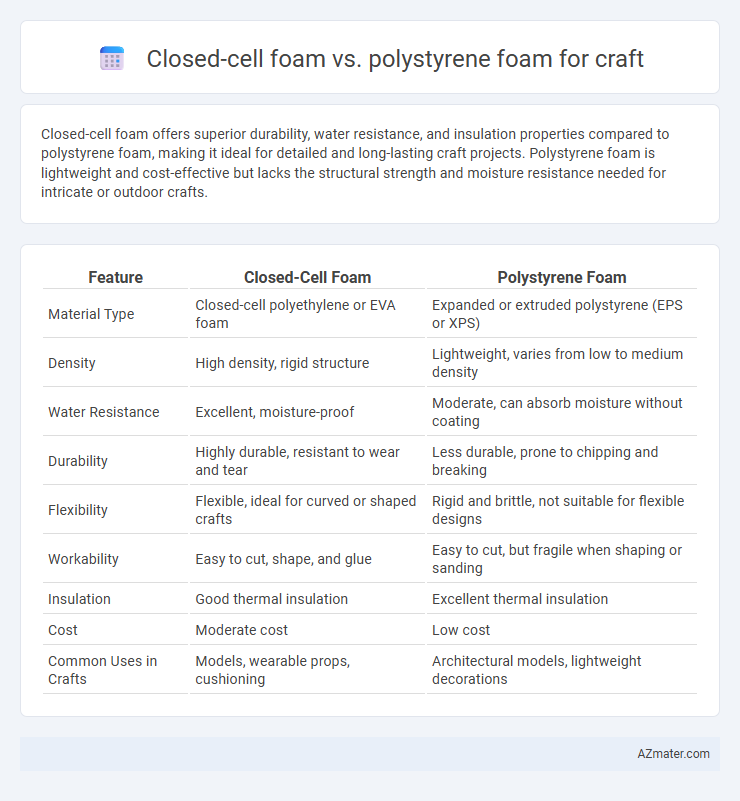Closed-cell foam offers superior durability, water resistance, and insulation properties compared to polystyrene foam, making it ideal for detailed and long-lasting craft projects. Polystyrene foam is lightweight and cost-effective but lacks the structural strength and moisture resistance needed for intricate or outdoor crafts.
Table of Comparison
| Feature | Closed-Cell Foam | Polystyrene Foam |
|---|---|---|
| Material Type | Closed-cell polyethylene or EVA foam | Expanded or extruded polystyrene (EPS or XPS) |
| Density | High density, rigid structure | Lightweight, varies from low to medium density |
| Water Resistance | Excellent, moisture-proof | Moderate, can absorb moisture without coating |
| Durability | Highly durable, resistant to wear and tear | Less durable, prone to chipping and breaking |
| Flexibility | Flexible, ideal for curved or shaped crafts | Rigid and brittle, not suitable for flexible designs |
| Workability | Easy to cut, shape, and glue | Easy to cut, but fragile when shaping or sanding |
| Insulation | Good thermal insulation | Excellent thermal insulation |
| Cost | Moderate cost | Low cost |
| Common Uses in Crafts | Models, wearable props, cushioning | Architectural models, lightweight decorations |
Understanding Closed-Cell Foam: Key Features
Closed-cell foam features a dense structure with interconnected cells that are completely sealed, providing superior water resistance and enhanced durability compared to polystyrene foam. This type of foam offers excellent insulation properties and greater strength, making it ideal for crafts requiring structural support and moisture protection. Its rigidity and resistance to compression distinguish it from the more brittle and less water-resistant polystyrene foam commonly used in lightweight craft projects.
What is Polystyrene Foam? Crafting Essentials
Polystyrene foam, a lightweight and rigid material composed of expanded polystyrene beads, serves as a popular choice in crafting for its ease of cutting, shaping, and painting. Unlike closed-cell foam, which is dense and flexible, polystyrene foam offers a firm structure ideal for building models, prototypes, and decorative items. Crafting essentials with polystyrene include precision knives, sandpaper, and adhesives compatible with its smooth surface to ensure clean cuts and durable finishes.
Durability Comparison: Closed-Cell vs. Polystyrene Foam
Closed-cell foam offers superior durability compared to polystyrene foam due to its dense structure that resists water absorption and crushing, making it ideal for long-lasting craft projects. Polystyrene foam, while lightweight and easy to shape, tends to be more brittle and prone to chipping or breaking under stress. For crafts requiring robust, resilient materials, closed-cell foam provides enhanced strength and longevity.
Lightweight Properties: Which Foam is Easier to Handle?
Closed-cell foam exhibits superior lightweight properties compared to polystyrene foam, making it easier to handle for intricate craft projects. Its dense yet flexible structure provides durability without adding significant weight, ideal for detailed cutting and shaping tasks. Polystyrene foam is lightweight but can be more brittle, leading to increased fragility during handling and crafting processes.
Cutting and Shaping: Crafting with Different Foam Types
Closed-cell foam offers superior precision in cutting and shaping due to its dense, uniform structure, allowing for clean edges and detailed designs ideal for intricate craft projects. Polystyrene foam, being more brittle and lightweight, tends to crumble or chip when cut, requiring sharper tools and cautious handling to achieve smooth shapes. Both foams respond well to hot-wire cutters, but closed-cell foam maintains structural integrity better, making it preferable for crafts needing durability and fine detail.
Adhesion and Paint Compatibility for Craft Projects
Closed-cell foam offers superior adhesion for craft projects due to its dense, non-porous structure that allows glue and paint to bond more effectively without absorption issues. Polystyrene foam, while lightweight and easy to shape, tends to have a more porous surface that can cause adhesives and paints to bead or peel, requiring primers or sealants for better compatibility. For optimal finish and durability in craft applications, closed-cell foam provides a more stable base for both paint and adhesive materials.
Water Resistance: Closed-Cell and Polystyrene Performance
Closed-cell foam offers superior water resistance due to its dense, impermeable structure that prevents water absorption, making it ideal for crafts exposed to moisture. Polystyrene foam, while lightweight and versatile, tends to absorb water over time unless treated or coated, which can compromise its durability in wet conditions. Choosing closed-cell foam ensures long-lasting performance and structural integrity in water-exposed crafting projects.
Safety and Toxicity Concerns in Foam Crafting
Closed-cell foam offers enhanced safety in craft projects due to its low chemical off-gassing and reduced risk of toxic fumes compared to polystyrene foam, which often releases styrene vapors during cutting and heating. Polystyrene foam's higher flammability and potential to emit hazardous chemicals can pose significant health risks, especially in poorly ventilated crafting environments. Selecting closed-cell foam minimizes exposure to volatile organic compounds (VOCs), supporting safer handling and indoor use in foam crafting applications.
Cost Analysis: Budgeting Your Craft Materials
Closed-cell foam offers higher durability and moisture resistance, making it slightly more expensive than polystyrene foam, which is lightweight and cost-effective for large-scale projects. Polystyrene foam is generally preferred for budget-conscious crafters due to its lower price per sheet and ease of shaping, despite being less durable than closed-cell varieties. When budgeting craft materials, factor in the project's longevity and usage environment to determine which foam provides the best value for your investment.
Best Applications: Choosing the Right Foam for Your Craft
Closed-cell foam offers excellent water resistance, durability, and cushioning, making it ideal for outdoor crafts, model building, and protective padding projects. Polystyrene foam provides lightweight structure and ease of shaping, perfect for decorative items, prototypes, and insulation in craft applications. Selecting the right foam depends on the craft's moisture exposure, structural needs, and design complexity to ensure durability and functionality.

Infographic: Closed-cell foam vs Polystyrene foam for Craft
 azmater.com
azmater.com